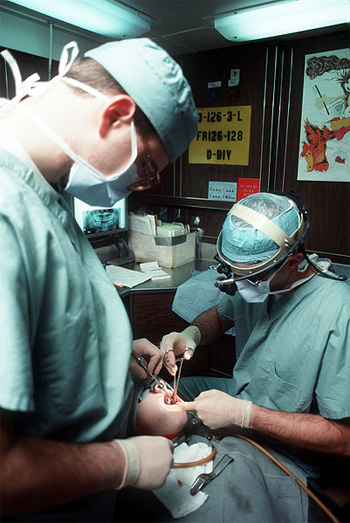Anaesthetic use – Background
 Anaesthetising the mouth when an upper back wisdom tooth needs to be removed involves two injections – one into the gum and one into the roof of the mouth. Although this is the currently accepted practice, there is little research evidence relating to the use of the palatal injection. The justification for using the palatal injection is based on the anatomy of the nerve supply to the mouth. The intention is to block the supply to the palatal nerve so that the rear part of the hard palate and the overlying soft tissues become numb. It is thought that this assists in anaesthetising the teeth.
Anaesthetising the mouth when an upper back wisdom tooth needs to be removed involves two injections – one into the gum and one into the roof of the mouth. Although this is the currently accepted practice, there is little research evidence relating to the use of the palatal injection. The justification for using the palatal injection is based on the anatomy of the nerve supply to the mouth. The intention is to block the supply to the palatal nerve so that the rear part of the hard palate and the overlying soft tissues become numb. It is thought that this assists in anaesthetising the teeth.
The palatal lignocaine injection can be quite painful as the tissues in the palate are quite dense. There can also be side effects later on, when the roof of the mouth can feel swollen, making breathing and swallowing uncomfortable. Mark Badcock believed that patients would not experience a greater level of discomfort during extraction if they did not have the palatal lignocaine injection. And, he hoped that if the palatal lignocaine injection could be avoided then patient would not have to experience the pain of the injection itself.
In this double-blind randomised controlled trial, it was important that neither the surgeon or the patient knew which side of the mouth would receive a palatal injection of lignocaine – the current standard of care. This also meant that the patients needed to receive two palatal injections – one with the active anaesthetic and one without. Hence Mark was able to compare the levels of pain experience with and without an active anaesthetic. Patients still experienced the pain of the palatal injection on both sides of the mouth.
Mark regarded the study design as a stringent test of his idea. His reasoning was that the side getting no palatal lignocaine was still getting the pain of a physical injection (with no active anaesthetic). If this side experienced less pain, or “equivalent” pain to the standard care group, then Mark felt that he could be confident that giving no palatal injection at all would be even better.